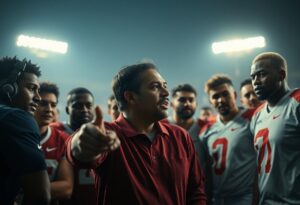Leadership in football goes far beyond merely wearing the captain’s armband; it encompasses strategy, inspiration, and unity on and off the pitch. As you explore the evolution of football leadership, you’ll discover how captains have not only influenced their teams but have also left a lasting impact on the sport itself. From legendary figures commanding respect to modern leaders fostering collaboration, the role of the captain has transformed significantly over the years, continually shaping the game you love and watching unfold. Join us as we investigate into this fascinating journey of leadership in football.
Historical Overview of Football Captains
Your understanding of football leadership begins with the deep-rooted history of captains in the sport. Through various epochs, these leaders have influenced not only their teams but also the evolution of the game itself. Their roles have expanded beyond mere tactical guidance to embody the ethos and spirit of football, leaving a lasting impact on generations of players and fans alike.
Early Leadership Roles
Captains in the early days of football primarily focused on ensuring that team strategies were adhered to during matches. Often chosen based on experience or seniority, these leaders acted as the liaison between players and officials, fostering communication and unity on the pitch. Their responsibilities set the stage for the evolving expectations of leadership in the sport.
The Impact of World Events on Leadership
About the evolution of football leadership, it’s imperative to consider how world events have influenced the role of captains. Significant historical moments, such as wars and social movements, shaped team dynamics and the qualities expected of a leader. Captains became symbols of resilience and strength, often emerging as voices of hope during tumultuous times.
Also, these world events often shifted the focus of football, prompting captains to adopt new leadership styles. For instance, during wartime, captains not only motivated their teams but also served as community icons, emphasizing solidarity and resilience. Such instances illustrate how external factors can dramatically reshape leadership roles within the sport, fostering a deeper connection between players and their representatives on the field.
Leadership Styles in Football
While the role of a football captain extends beyond mere tactical decisions, distinct leadership styles have emerged over the years. Captains not only guide their teams on the pitch but also inspire their teammates off it. Your understanding of these styles can deepen your appreciation of the game and its strategic nuances.
Tactical vs. Motivational Leadership
Below the surface of football team dynamics, tactical leadership focuses on game strategy, while motivational leadership emphasizes boosting team morale. You may find that effective captains often blend these two styles, adapting their approach based on the needs of the moment and their team’s spirit.
Iconic Captains and Their Approaches
The influence of iconic captains showcases a variety of leadership approaches that have shaped football history. You can see how figures like Franz Beckenbauer and Steven Gerrard captained their teams by combining tactical acumen with profound motivational skills.
To appreciate the impact of these iconic captains, consider their unique approaches. For instance, Beckenbauer’s tactical insight transformed defensive play, while Gerrard’s unwavering determination and charisma inspired teammates. Each captain’s distinct personality and leadership style not only guided their teams to victories but also left lasting legacies that influence aspiring leaders in the sport today.
The Evolution of the Captaincy Role
Assuming you look back at the history of football, you’ll find that the role of the captain has evolved significantly over time. Initially viewed as a mere formality, captains have transformed into pivotal figures on and off the pitch. Your perception of the captaincy has likely shifted, influenced by changing team dynamics and the increasingly demanding expectations placed upon leaders in the sport. This evolution reflects a broader trend in how leadership is viewed in football today.
Changing Expectations of Captains
Above all, today’s captains are expected to embody leadership qualities that extend beyond just tactical awareness. You may notice that modern captains must effectively manage diverse personalities and foster team cohesion while also being exemplary performers on the field. This shift in expectations signifies a more comprehensive role, requiring emotional intelligence alongside physical skill.
Influence of Technology and Analytics
Influence from technology and analytics is reshaping how captains approach their leadership responsibilities. You might find that current captains are not only skilled players but also adept at understanding complex data that can help in strategic decision-making. With real-time analytics, your captain can make informed choices that can change the game.
The growth of technology and analytics has introduced a data-driven approach to football, significantly impacting the captain’s role. You now see captains utilizing performance metrics to inform their in-game strategies and team discussions. This reliance on data enhances their decision-making ability while ensuring they guide their teammates based on sound analysis. As a result, captains are becoming more multifaceted leaders who combine intuition and analytical skills to elevate their teams’ performances.
Case Studies of Influential Captains
For football enthusiasts, examining the journey of influential captains offers invaluable insights into leadership in the sport. Here’s a compilation of pivotal case studies that exemplify how captains have shaped their teams and the game itself:
- Diego Maradona, Argentina – Led his team to a World Cup victory in 1986, scoring five goals and providing five assists.
- Franz Beckenbauer, Germany – Captained the 1974 World Cup-winning team, then coached the 1990 champions, showcasing versatility in leadership.
- John Terry, Chelsea – Captained the team to multiple Premier League titles and a UEFA Champions League victory in 2012.
- Carles Puyol, Spain – Captained Barcelona to numerous titles, including the 2009 treble, and led Spain to triumph at the 2010 World Cup.
- Rafa Marquez, Mexico – An influential figure in Mexican football, serving as captain in multiple World Cups and a key player in MLS.
Legendary Captains and Their Legacies
By studying legendary captains, you gain a deeper understanding of how their unique styles forged winning mentalities and inspired their teammates. Their legacies are often interwoven with the history of football itself, influencing generations to embrace leadership qualities both on and off the pitch.
Contemporary Leaders in Modern Football
An exploration of contemporary leaders reveals how modern football captains adapt their strategies to fit the fast-paced, competitive environment of today’s game. These professionals exhibit distinctive leadership styles, proving that adaptability is key in maintaining team success.
To fully grasp the impact of contemporary leaders, you must observe how they cultivate team dynamics and motivate younger players. Captains like Liverpool’s Jordan Henderson and Manchester City’s Fernandinho exemplify how communication, emotional intelligence, and tactical acumen enhance team cohesion. Their influence stretches from training grounds to matchday performances, illustrating that leadership in football continues to evolve while remaining a foundational element of success.
The Role of Captains in Team Dynamics
All successful teams recognize the importance of captains in fostering an effective team dynamic. These leaders are responsible for galvanizing their teammates, ensuring that everyone understands their roles, and maintaining a shared vision. Your captain’s influence can instill discipline, motivation, and a sense of responsibility, ultimately leading to better teamwork and enhanced performance on the field.
Building Team Cohesion
One of the primary responsibilities of a captain is to build team cohesion. By encouraging collaboration and trust among players, the captain creates an environment where individuals feel valued and empowered. This sense of belonging can significantly impact your team’s effectiveness, as players are more likely to work harmoniously towards a common goal.
Conflict Resolution and Communication
About the challenges that arise during a season, captains play a vital role in conflict resolution and communication. They serve as a bridge between players and coaching staff, ensuring that concerns are addressed and that everyone remains aligned. Your captain’s ability to facilitate open dialogue can lead to improved relationships and a more positive atmosphere within the team.
It’s imperative for a captain to possess strong communication skills to navigate conflicts effectively. When tensions escalate, your captain must address issues promptly and constructively, promoting understanding rather than division. By fostering an open environment where teammates feel comfortable expressing their concerns, the captain helps to mitigate misunderstandings and conflicts. This commitment to communication not only resolves immediate issues but also contributes to long-term team harmony and success.
Future Directions in Football Leadership
Not only are today’s captains expected to provide tactical insights, but they must also foster unity among diverse team members. As the landscape of football evolves, players originating from various cultural backgrounds require leadership that is both adaptive and inclusive. This shift signifies that the role of the captain will increasingly expand beyond the pitch, focusing on interpersonal dynamics and emotional intelligence to cultivate a thriving team environment.
Emerging Trends in Team Leadership
To navigate the rapidly changing dynamics of football, you should keep an eye on emerging trends in team leadership. Modern captains are integrating advanced analytics and technological tools into their decision-making processes, enhancing strategies while promoting collaborative team environments. Additionally, teams are prioritizing leadership development programs, equipping all players with leadership skills that extend beyond the captaincy.
The Role of Captains in a Globalized Sport
Sport is now more interconnected than ever, and this globalization presents both challenges and opportunities for captains. You will find that leaders in football are guiding teams with players from various cultural backgrounds, each with unique perspectives and skills. Captains must bridge the gap between these cultures, fostering mutual respect and understanding. This is crucial for team cohesion and success, encouraging an atmosphere where every player’s voice is valued and heard.
Leadership in this context extends beyond traditional commanding roles; it requires diplomatic skills to navigate cultural differences effectively. As captains, you have to promote inclusivity and harness the strengths of every team member, ensuring that individual talents contribute to the overall success of the team. By emphasizing communication and collaboration, you can help create a cohesive unit that thrives in the global arena of football.
Final Words
To wrap up, your understanding of football leadership has likely deepened as you’ve explored how captains have significantly influenced the game’s evolution. From iconic personalities implementing tactical innovations to inspiring their teammates through camaraderie and resilience, you see that the role of a captain transcends mere performance on the pitch. By appreciating these dynamics, you can better recognize how effective leadership shapes not just individual careers but also the overall ethos of football as a sport.




